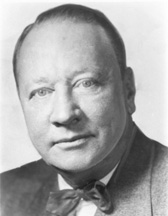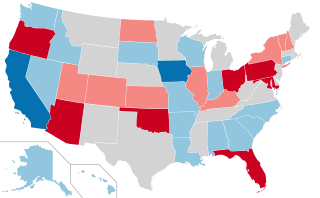
Cameron A. Morrison was an American politician and the 55th governor of the U.S. state of North Carolina from 1921 to 1925.

Robert Rice Reynolds was an American politician who served as a Democratic US senator from North Carolina from 1932 to 1945. Almost from the outset of his Senate career, "Our Bob," as he was known among his local supporters, acquired distinction as a passionate isolationist and increasing notoriety as an apologist for Nazi aggression in Europe. Even after America's entry into World War II, according to a contemporary study of subversive elements in America, he "publicly endorsed the propaganda efforts of Gerald L. K. Smith," whose scurrilous publication The Cross and the Flag "violently assailed the United States war effort and America's allies." One of the nation's most influential fascists, Smith likewise collaborated with Reynolds on The Defender, an antisemitic newspaper that was partly owned by Reynolds.

The 1986 United States Senate elections were elections for the United States Senate. Held on November 4, in the middle of Ronald Reagan's second presidential term, the 34 seats of Class 3 were contested in regular elections. The Republicans had to defend an unusually large number of freshman Senate incumbents who had been elected on President Ronald Reagan's coattails in 1980. Democrats won a net of eight seats, defeating seven freshman incumbents, picking up two Republican-held open seats, and regaining control of the Senate for the first time since January 1981. This remains the most recent midterm election cycle in which the sitting president's party suffered net losses while still flipping a Senate seat.

The 1978 United States Senate elections were held on November 7, in the middle of Democratic President Jimmy Carter's term. The 33 seats of Class 2 were contested in regular elections. Special elections were also held to fill vacancies.

The 1968 United States Senate elections were elections for the United States Senate. Held on November 5, the 34 seats of Class 3 were contested in regular elections. They coincided with the presidential election of the same year. The Republicans picked up five net seats in the Senate. This saw Republicans win a Senate seat in Florida for the first time since Reconstruction.

The 1958 United States Senate elections were elections for the United States Senate which occurred in the middle of President Dwight D. Eisenhower's second term. Thirty-two seats of Class 1 were contested in regular elections, the new state of Alaska held its first Senate elections for its Class 2 and 3 seats, and two special elections were held to fill vacancies.

The 1954 United States Senate elections was a midterm election in the first term of Dwight D. Eisenhower's presidency. The 32 Senate seats of Class 2 were contested in regular elections, and six special elections were held to fill vacancies. Eisenhower's Republican party lost a net of two seats to the Democratic opposition. This small change was just enough to give Democrats control of the chamber with the help of the Independent who at the start of this Congress in January 1955 agreed to caucus with them; he later officially joined the party in April 1955.

The 1938 United States Senate elections occurred in the middle of Franklin D. Roosevelt's second term. The 32 seats of Class 3 were contested in regular elections, and special elections were held to fill vacancies. The Republicans gained eight seats from the Democrats, though this occurred after multiple Democratic gains since the 1932 election, leading to the Democrats retaining a commanding lead over the Republicans with more than two-thirds of the legislative chamber.

The 1932 United States Senate elections coincided with Democrat Franklin D. Roosevelt's landslide victory over incumbent Herbert Hoover in the presidential election. The 32 seats of Class 3 were contested in regular elections, and special elections were held to fill vacancies.

The 1930 United States Senate elections occurred in the middle of Republican President Herbert Hoover's term. The 32 seats of Class 2 were contested in regular elections, and special elections were held to fill vacancies. With the Great Depression beginning to take hold, Republican incumbents became unpopular, and Democrats picked up a net of eight seats, erasing the Republican gains from the previous election cycle, however, Republicans retained control of the chamber. This was the first of four consecutive Senate elections during the Depression in which Democrats made enormous gains, achieving a cumulative pick-up of 34 seats.

The North Carolina United States Senate election of 1968 was held on 5 November 1968 as part of the nationwide elections to the Senate. The general election was fought between the Democratic incumbent Sam Ervin and the Republican nominee Robert Somers. Ervin won re-election to a third full term, with over 60% of the vote. This was the last time any incumbent was re-elected in this seat until 2010. To date, this is also the last time a Democrat was re-elected as a senator in North Carolina.

The 1984 North Carolina gubernatorial election was held on November 6, 1984. Democratic incumbent Jim Hunt was unable to run for another consecutive term under the North Carolina Constitution. Hunt ran instead for the U.S. Senate against Jesse Helms and lost, although he later announced his campaign for a third gubernatorial term in the 1992 election. Popular 9th District Congressman James G. Martin ran as the Republican nominee against Democratic Attorney General Rufus L. Edmisten, who defeated Hunt's Lt. Governor, James Green, among other candidates, in a hotly contested primary.

The 1934 United States Senate election in Minnesota took place on November 6, 1934. Incumbent Farmer–Labor U.S. Senator Henrik Shipstead defeated former State Senator Nathaniel J. Holmberg of the Republican Party of Minnesota and U.S. Representative Einar Hoidale of the Minnesota Democratic Party to win a third term.

The 1932 United States Senate elections in Arizona took place on November 8, 1932. Incumbent Democratic U.S. Senator Carl Hayden ran for reelection to a second term, again defeating his 1926 challenger former U.S. Senator Ralph H. Cameron in the general election.

The 1930 Pennsylvania gubernatorial election occurred on November 4, 1930. Incumbent Republican governor John Stuchell Fisher was not a candidate for re-election. Republican candidate and former governor Gifford Pinchot defeated Democratic candidate John M. Hemphill to win a second, non-consecutive term as Governor of Pennsylvania.

The 1930 United States Senate election in Maine was held on September 8, 1930. Incumbent Republican U.S. Senator Arthur Gould, who had been elected to complete the term of the late Senator Bert Fernald, did not run for re-election to a full term.

The 1938 United States Senate election in North Carolina was held on November 7, 1938. Incumbent Democratic Senator Robert Rice Reynolds was re-elected to a second term in office, defeating U.S. Representative Franklin Wills Hancock Jr. in the Democratic primary and Republican former U.S. Representative Charles A. Jonas in the general election.

The 1926 United States Senate election in North Carolina was held on November 2, 1926. Incumbent Democratic Senator Lee Slater Overman was re-elected to a fifth term in office, defeating Republican Johnson Jay Hayes.

The 1944 United States Senate election in North Carolina was held on November 7, 1944. Incumbent Democratic Senator Robert Rice Reynolds did not run for a third term in office. Former Governor of North Carolina Clyde R. Hoey won the open seat, defeating U.S. Representative Cameron A. Morrison in the Democratic primary and Republican attorney A.I. Ferree in the general election.

The 1954 United States Senate election in North Carolina was held on November 2, 1954. Interim Democratic Senator Alton A. Lennon, who had been appointed to fill the vacant seat left by the death of Willis Smith, ran for re-election. Lennon lost the Democratic primary to former Governor W. Kerr Scott, who easily won the general election over Republican Paul C. West.

















